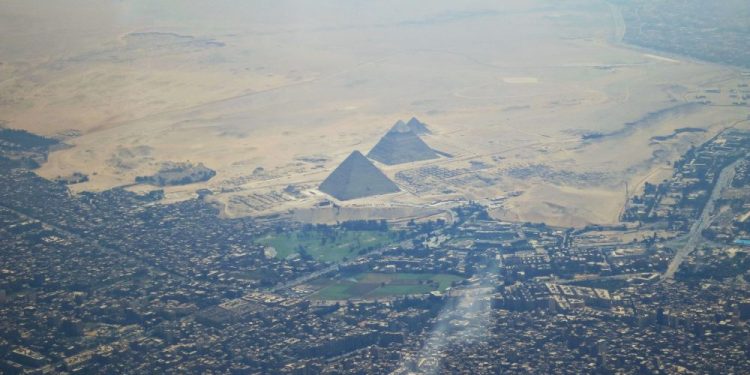Most people on Earth who have at least seen images of the Great Pyramid of Giza would probably agree that of all the pyramids on Earth that have been discovered to this date, the Great Pyramid of Giza is the most mesmerizing one. The Great Pyramid of Giza is one of the most fascinating ancient structures ever built on the planet, and it is not just because of its tremendous size or incredible design.
The Great Pyramid, identified as the tomb of Pharaoh Khufu–perhaps wrongly–is unique for several reasons. Standing proud at the Giza plateau not far from modern-day Cairo, the Great Pyramid was the first smooth-sided Pyramid built on the plateau. However, it was not the first in Egypt. In fact, before the Great Pyramid of Giza was constructed, many pyramids were erected in the land of Pharaohs. As noted by Mark Lehner, one of the most famous Egyptologists to have researchers pyramids and one of the scholars who argue the Pyramids of Egypt were used as royal tombs, it is hard to overemphasize the dramatic leap in the architectural size and sophistication represented by Egypt’s first royal stone complex, the Step Pyramid Complex of Djoser at Saqqara.
Origin of Ancient Egyptian Pyramids
The origin of ancient Egyptian pyramids can be traced back to around 2,780 BC when Pharaoh Djoser built the Step Pyramid. Although not the first of the structures built during his reign, the Step Pyramid Complex at Saqqara represented a massive and sudden innovation in ancient Egyptian architecture.
One hundred years would pass before Pyramid building techniques were revolutionized again when King Sneferu came to the throne of ancient Egypt and kickstarted the evolution of pyramid building in Egypt. It was Sneferu’s Bent Pyramid that marked a turning point in pyramid building in Egypt. Rising from the desert at a 54-degree inclination, the Bent Pyramid was redesigned several times during construction. It was finished with a much shallower angle of 43 degrees, precisely giving it its obvious bent shape.
Transitional form
But this Pyramid at Dahshur represents a clear transitional form between Djoser’s Step Pyramid and smooth-sided pyramids, which would be perfected by the time the Great Pyramid of Giza was completed. In addition to that, the Bent Pyramid of Sneferu is also unique among the more than 100 pyramids of Egypt, and that’s due to its original polished limestone outer casing, which remains largely intact.
No other pyramid in Egypt still bears so many of its outer casing stones. The precisely placed, well-polished limestone gives justice to its ancient name; the Bent Pyramid is generally translated as (The)-Southern-Shining-Pyramid, or Sneferu-(is)-Shining-in-the-South. When the Pyramid was completed, it would most likely have shone extremely bright and been visible from miles away as it reflected the shining sun.
True smooth-sided Pyramid
After the Bent Pyramid, Sneferu would not refrain from Pyramid building. On the contrary, he built one that was even more stunning than the Bent Pyramid. Also, at Dahshur, Pharaoh Sneferu commissioned the construction of what is now recognized as the first true smooth-sided Pyramid of Egypt, the Red Pyramid.
Sneferu built the third-largest Pyramid in Egypt, and during his reign, it was Egypt’s largest, most sophisticated smooth-sided Pyramid. The Red Pyramid, also known as the North Pyramid, was built with a shallow 43-degree angle, just like the upper parts of the Bent Pyramid of Dashur, signalizing a normative in terms of pyramid building.
Experts argue that the Red Pyramid was built in no more than 17 years, in which the builders completed a massive structure with a total volume of 1,694,000 cubic meters (59,823,045 cu ft). The design of the Red Pyramid is most likely the direct result of the development of the pyramid building at Dahshur and Saqqara. Long before the Red Pyramid was built, there were numerous failed attempts at pyramids in Egypt. One such example is the Pyramid at Meidum, one of the first pyramids attempted by Sneferu.
Eventually, Sneferu passed his throne to Khufu, his son, and the Pyramid building in Egypt reached its peak. As noted by Ahmed Fakry, the Great Pyramid of Giza represents the culminative effort of the pyramid builders. Not only is the Great Pyramid of Giza the largest monument ever constructed, but for the excellence of workmanship, the accuracy of planning, and the beauty of proportion, it remains the chief of the Seven Wonders of the Ancient World.
Fascinating facts
Many people would agree that no mere description can do the Great Pyramid justice or even convey an idea of its true size. Scholars have worked out several meticulous calculations to relate the structure’s height and bulk with other monuments built across the planet.
As noted by some measurements, the base area would contain the cathedrals of Florence and Milan, St. Peter’s in Rome, St Paul’s Cathedral, and Westminster Abbey in London. If all the stones in the Pyramid were sewed into blocks one-foot square, and these blocks were laid to end, they would stretch two-thirds of the way around our planet at its equator. The Great Pyramid of Giza was built with around 2.3 million blocks of stone, many weighing more than 3 tons. It has been calculated that the total weight of the Great Pyramid of Giza is around 6 million tons.
But the Great Pyramid at Giza has stunned people since time immemorial. In fact, during his campaign in Egypt, Napoleon calculated that the Great Pyramid and its neighboring structures contained enough stone to construct a wall 3 meters high and 1 meter thick, which would enclose all of France. Napoleon’s calculations were corroborated by a mathematician who was among the savants that accompanied his expedition to Egypt.
In addition to its tremendous size and the amount of stone used in the construction of the Pyramid, the relationship that exists between the Pyramid and the Earth is unsettling for some: Taking the Great Pyramid’s height and multiplying it by 43.200, you obtain 3938.685 miles, which is short 11 miles of the actual measurements for the polar radius of our planet.
Taking the perimeter at the base of the Pyramid and multiplying it by 43,200, we get 24,734.94 miles—a result short of 170 miles of the true equatorial circumference of our planet.
The accuracy of the Great Pyramid of Giza is another stunning feature. As noted by Lehner, the base of the Great Pyramid is level to within just 2.1 centimeters; the average deviation of the sides from the cardinal direction is 3’6″ of arc; the greatest difference in the length of the sides of the Great Pyramid is 4.4 centimeters. The exact purpose behind such striking precision remains largely unexplained.
Misconceptions about the Great Pyramid of Giza
- Since the Great Pyramid of Giza is like a rockstar of the ancient world, many misconceptions about it are found in books and the internet. Slaves did not build the Great Pyramid of Giza, as some people may have read on the internet and even history books for a few decades. This rumor was started by the Greek writer Herodotus who visited the Great Pyramid around 400 BC. Herodotus heard stories from alleged priests, which he eventually used as facts in his writing. Today, we know that the Pyramid was not built by slaves but by well-paid workers.
- The Great Pyramid is often confused with the Pyramid of Khafre. The Great Pyramid of Giza is the largest pyramid on the Giza plateau. In second place is the Pyramid of Khafre, who was Khufu’s son. In many online magazines and even news reports, we see an image of the Pyramid of Khafre with a description alluding that it is the Great Pyramid of Giza. The difference between the two is actually easy to spot: Khafre’s Pyramid has some casing stones still on its summit. On the other hand, the Great Pyramid lacks all of its casing stones from the top. The Pyramid’s summit or “casing stone” is also missing.
- Although the three pyramids at Giza are majestic in size and design, the aren’t three great Pyramids. We often hear about the pyramids at Giza called the Great Pyramids of Giza. There’s only one Great Pyramid of Giza, the largest and oldest of the three main pyramids built on the plateau.
- Many–if not most–of the images of the pyramids make them appear almost as if they were built in the middle of the desert, and nothing surrounds them. The truth is that they were built in the desert (the Giza plateau, to be specific), but they were not far from towns and other structures. Today, the Pyramids stand not far from Giza and are surrounded by a modern jungle of buildings.
- The Great Pyramid of Giza is –not–the oldest Pyramid in Egypt. As I’ve already explained in the article, the Great Pyramid of Giza results from a long line of pyramids in Egypt, starting with what many mainstream Egyptologists believe was the Step Pyramid of Djoser. The exact age of the Pyramid remains a highly debated subject, although mainstream scholars love that the Great Pyramid of Giza was built some 4,500 years ago.
- The interior of the Great Pyramid remains unexplored. Yes, people can enter the Pyramid and visit the Grand Gallery, the King’s Chamber, and the Queen’s Chamber, but there are still rooms inside the Pyramid that have not been discovered. Evidence of that fact is a discovery made by the ScanPyramids project, which discovered a previously unknown chamber in the middle of the Pyramid. We have still not accessed it, but it leads us to believe there are many more similar cavities within the Pyramid.
- The Great Pyramid of Giza does not have four sides. That’s right. The Great Pyramid of Giza is the only eight-sided Pyramid out there. This strange yet fascinating characteristic is only visible from the air, at either dawn or sunset, on the spring and autumn equinoxes when the sun casts shadows on the Pyramid.
- The Great Pyramid of Giza, although the largest of all ancient Egyptian pyramids, is not the largest Pyramid on the planet. It may be the tallest, but it certainly isn’t the largest in volume. The largest Pyramid built on Earth is the Great Pyramid of Cholula, located in modern-day Mexico. The base of the Great Pyramid of Cholula measures a stunning 160,000 square meters, which means it is three times the area of the 53,056.5 square meter base area of the Great Pyramid at Giza.
- The Pyramids were built with ramps and primitive tools. Although the most acceptable theory concerning the construction of the Great Pyramid is that it was built by people dragging massive blocks of stone through the desert, using nothing but primitive tools made of stone or copper, making use of ramps, the truth is that we still don’t know for certain. There isn’t a single ancient text that mentions the exact construction method of the Great Pyramid of Giza.
Have something to add? Visit Curiosmos on Facebook. Join the discussion in our mobile Telegram group.











